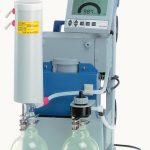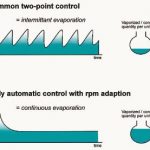Various methods for application-specific vacuum control are compared in the following with regard to their value for users. The most important criteria are process time, solvent recovery rate and ease of use and handling. Modern, speed-controlled chemical diaphragm pumping units with fully automatic control, like the Vario systems, provide optimum efficiency.
Dr. Juergen Dirscherl
Many processes benefit from operation under a controlled vacuum. The best example is a rotary evaporator. By applying a suitable low pressure, which is as close as possible to the boiling point of the solvent to be evaporated, distillations can be run at low temperatures. If the applied pressure is too high, the evaporation takes unneces-sarily long. If it is too low, the solvents tend to foam over, thus spoiling the experiment. The technique used to control the process vacuum is critical to performance from both a commercial and an ecological viewpoint.
Manual control
In recent years, many water-jet pumps and oil-sealed rotary vane pumps have been replaced by modern and more sophisticated chemical diaphragm pumps. Numerous manual systems are still used, however to control the vacuum level. Early systems employed air admittance valves to use up some of the pumping speed – a disadvantage as regards solvent recovery and operating noise. Inline tube clamps to control the pump flow are a better solution. More advanced systems rely on PTFE valves mounted directly at the pumping unit. It should not be forgotten, however, that this kind of valve only regulates the pumping speed by throttling and not the vacuum level. Although experienced users can achieve good results with manually controlled systems, the majority of them do not have the time to regulate the optimum vacuum level regularly – a task that can easily take several hours, depending on the application. The evaporation itself causes the solvent temperature and composition to change continuously. As a result, the boiling point shifts and the user has to adjust the valve in order to keep the process running.
Automatic control
Automatic vacuum controllers maintain a constant vacuum level. One common method is to regulate the pressure using an electromagnetic 2-point valve (open-close). High-quality systems of this kind offer true vacuum control and enable a large number of processes to be operated within a reasonable time, yet demand only minimal user intervention. The pump runs at full speed and the controller measures the pressure in the chamber. As soon as the pressure drops below a preset level, the valve between the pump and the chamber is closed. The valve opens again when the pressure rises above this preset level plus a hysteresis (necessary to prevent the valve from flickering).
Although the performance is good, the pressure varies between the upper and lower setpoints. As the system often works considerably above the optimum pressure (boiling point), the process time is relatively long. During periods with an open valve, full pumping speed is applied to the liquid surface and fluid droplets can be sucked into the pump. In periods with a closed valve, on the other hand, the evaporation more or less stops completely. Simple, low-cost controllers tend to under- or overshoot, making process control very difficult. Non-vacuum specialists often cannot cope with such problems. The user needs to know suitable values for the vacuum setpoint and hysteresis. However, these values differ for every solvent and every bath temperature. As soon as the evaporation starts, the solvent temperature drops due to evaporative cooling. It is thereafter mainly determined by the heat transfer from the bath. If the heating power is insufficient, the temperature decreases. Some controllers allow pres-sure ramps to be programmed. However, this further increases the number of free parameters. These systems are not able to determine and follow boiling points automatically.
Continuous vacuum level control
The solution to this common problem is continuous control of the vacuum level using a variable-speed motor to drive the chemical diaphragm pump. Although it sounds straightforward, accomplishing user-friendly and economical speed control from >2000 rpm almost down to standstill represents a formidable technical challenge. Optimum performance can only be achieved in combination with a fully automatic vacuum controller similar to that used in the Vacuu-brand Vario system. Pressure under- and overshooting are avoided, and the pres-sure is controlled extremely precisely without hysteresis. Fully automatic vacuum controllers with fuzzy logic find the boiling pressure(s) of the solvent mixtures by analysing the pressure characteristic during pump-down. The boiling point is approached carefully to prevent foaming. If the boiling pressure shifts, the vacuum level is adjusted to enable it to be followed precisely and fully automatically, with no need to adjust other parameters.
Advantages
Faster processing speeds increase throughput, reducing laboratory operating costs. If the daily costs for manpower are taken into account when calculating the total cost of ownership, Vario pumping units achieve an excellent score. This is even more important when it comes to modern, parallel evaporation units with their high operating costs per hour. Vario systems facilitate exceptionally efficient distillations, resulting not only in short evaporation times but also in high solvent recovery rates close to 100 %. The low noise and vibration level are added benefits – the pump runs most of the time at a comparatively slow speed. This also improves the lifetime of wearing parts. The service life of diaphragms and valves is determined by the number of strokes. Vacuubrand pumps typically achieve dia-phragm lifetimes of 10,000 h (or more) in constant-speed operation at 50 Hz. As Vario pumps usually run at low speeds, this means many years of maintenance-free operation.
cpp 454
More information on the product
Industry Exhibition – Ilmac 2005
Share:








